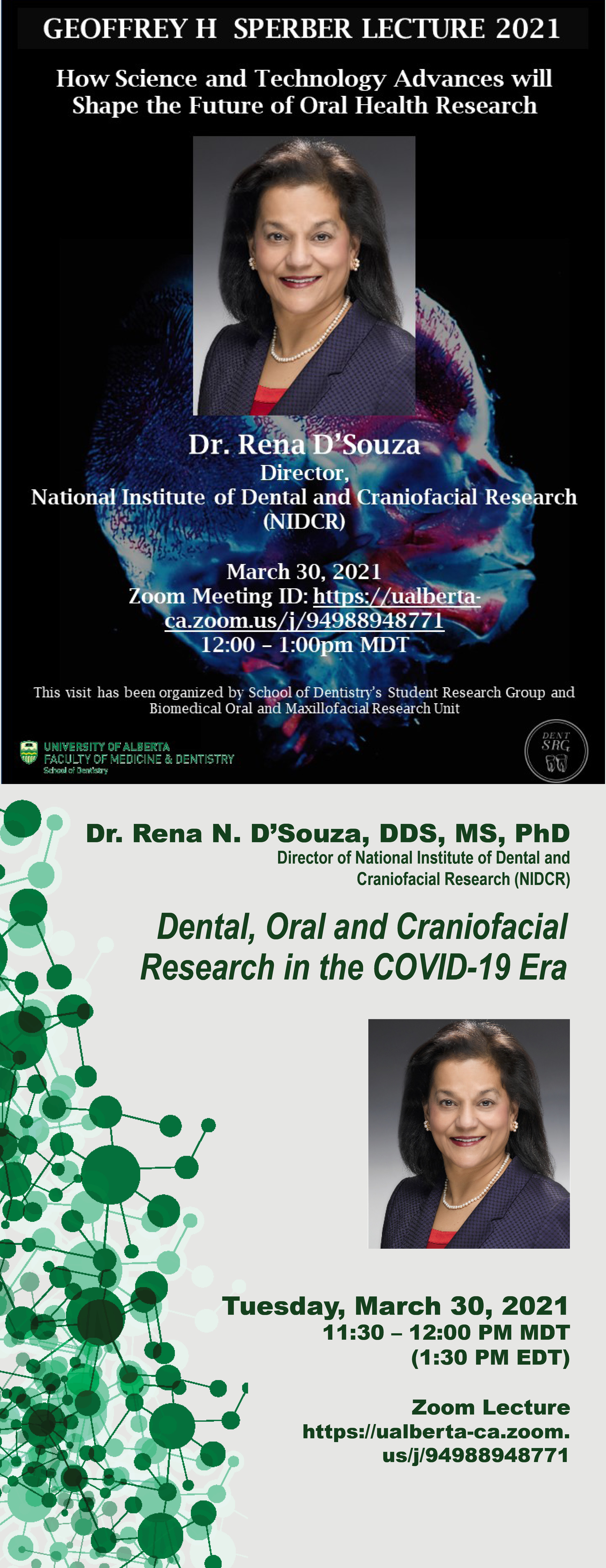Geoffrey H Sperber Lecturer 2021: Dr. Rena D’Souza
9 March 2021

The School of Dentistry is pleased to host Dr. Rena N. D’Souza, Director of National Institute of Dental and Craniofacial Research (NIDCR), for this year’s Geoffrey H Sperber Lecture.
Tuesday, March 30, 2021
11:30 – 12:00 PM
Dental, Oral and Craniofacial Research in the COVID-19 Era
12:00 – 13:00 PM
Geoffrey H Sperber Lecture: How Science and Technology Advances will Shape the Future of Oral Health Research
Where: Zoom Lecture
https://ualberta-ca.zoom.us/j/94988948771
Meeting ID: 949 8894 8771
One tap mobile: +14388097799,,94988948771# Canada; +15873281099,,94988948771# Canada
If needed: +1 929 205 6099 (New York); +1 301 715 8592 (Washington DC)
Prior to becoming NIDCR’s director, Dr. D’Souza served in the position of Associate Vice Provost for Research for the University of Utah and as Assistant Vice President for Academic Affairs and Education for the Health Sciences. She held the Ole and Marty Jensen endowed chair in the School of Dentistry where she served as inaugural dean. As a clinician-scientist, D’Souza has been strongly committed to discovery and mentoring throughout her academic career. She is a past president of the American Association for Dental Research (AADR) and the International Association for Dental Research (IADR). Dr. D’Souza has authored over 150 publications and book chapters in the areas of craniofacial development, matrix biology and tissue regeneration for over 30 years. Dr. D’Souza continues to maintain an active research laboratory in the National Institute of Child Health and Human Development (NICHD), NIH. Her presentation is titled “How Science and Technology Advances will Shape the Future of Oral Health Research”. Prior to the Sperber lecture, Dr. D’Souza will provide a short summary of the COVID-19 research efforts taking place at NIDCR.
About the Lectures
Dental, Oral, and Craniofacial Research in the COVID-19 Era
11:30 – 12:00 PM MDT (1:30 PM EDT), Tuesday March 30, 2021
Zoom Lecture
https://ualberta-ca.zoom.us/j/94988948771
The National Institute of Dental and Craniofacial Research (NIDCR) is the U.S. federal government’s lead agency for scientific research on dental, oral, and craniofacial health and disease. NIDCR funds a dynamic portfolio of dental, oral, and craniofacial research spanning basic, translational, social and behavioral, and clinical research domains, and supports a strong research workforce through training and career development awards.
The COVID-19 pandemic has driven unprecedented advances in science and technology, while also creating unique challenges in the field of dental, oral, and craniofacial research. NIDCR is committed to answering essential scientific questions about this novel coronavirus through both intramural and extramural research. Intramural researchers have focused on COVID-19 activities that are uniquely suited to the NIH campus, including investigating transmissibility and viral load of SARS-CoV-2 in oral secretions, quantitative antibody testing of COVID-19 infection, and the structure of the SARS-CoV-2 spike protein in saliva. NIDCR has also supported extramural COVID-19 supplements targeted to dental settings, including COVID-19 vaccine readiness among dentists, PPE use, and aerosol and droplet transmission. NIDCR also administers grants as part of the NIH’s Rapid Acceleration of Diagnostics Radical (RADx-rad) initiative, which encourages development of nontraditional approaches to address gaps in COVID-19 testing and surveillance. NIDCR will continue to invest in research and training to meet the twin challenges of curtailing the COVID-19 pandemic and preparing us to respond far better to future pandemics.
How Science and Technology Advances will Shape the Future of Oral Health Research
12:00 – 1:00PM MDT (2:00 PM EDT), Tuesday March 30, 2021
Zoom Lecture
https://ualberta-ca.zoom.us/j/94988948771
In recent years, our knowledge of the genetic and molecular control of craniofacial and palatal morphogenesis has greatly increased. However, the interactions between signalling pathways that regulate the growth and fusion of palatal shelves are largely unknown. Since it is the interaction between molecules rather than the intrinsic functions of any individual gene product that is responsible for the orchestration of pattern formation, this is an important problem that is critical to resolve. For the first time, we show that the Wnt gene signalling pathway is important in palatogenesis. Our data also illustrate the importance of the role of ectodysplasin (Eda/r) signalling in the Pax9-mediated Wnt pathway. Using the Pax9 mutant mouse model for tooth agenesis and cleft palate formation we further delineate the roles of signalling pathways. Controlled in-utero delivery of small molecule Wnt and Eda agonist therapy consistently induces palatal shelf closure in Pax9 mutant mouse embryos. Collectively, these studies advance our understanding of how key signalling pathways interact during normal and abnormal palate formation. Such basic science knowledge will provide a strong biologic rationale for the development of safe therapies that can prevent or correct cleft defects in humans.
About the Geoffrey H. Sperber Lecture
The Geoffrey H. Sperber lecture serves as a tribute to Dr. Geoffrey Sperber’s long and distinguished career as a scientist and educator. This lecture was inaugurated in 2017 as part of the centennial celebration of School of Dentistry at University of Alberta. It recognizes Dr. Sperber, who has been an outstanding member of our faculty for 60 years, and is the most prestigious lectures given at the University of Alberta by outstanding researchers in the field of craniofacial development, genetics, and biology.
About Dr. Geoffrey H. Sperber
 Dr. Geoffrey H. Sperber joined University of Alberta, Canada in 1961 after completing his bachelors in Dentistry from University of Witwatersrand and MSc from University of Rochester. He served as a full professor in Dentistry until 1996 and keeps publishing as Professor Emeritus until today. Dr. Sperber has authored a series of definitive books on craniofacial embryology, starting with Craniofacial Embryology introduced in 1973, which almost immediately became the primary reference for dental education. Craniofacial Embryogenetics and Development is now in its 3rd edition.
Dr. Geoffrey H. Sperber joined University of Alberta, Canada in 1961 after completing his bachelors in Dentistry from University of Witwatersrand and MSc from University of Rochester. He served as a full professor in Dentistry until 1996 and keeps publishing as Professor Emeritus until today. Dr. Sperber has authored a series of definitive books on craniofacial embryology, starting with Craniofacial Embryology introduced in 1973, which almost immediately became the primary reference for dental education. Craniofacial Embryogenetics and Development is now in its 3rd edition.